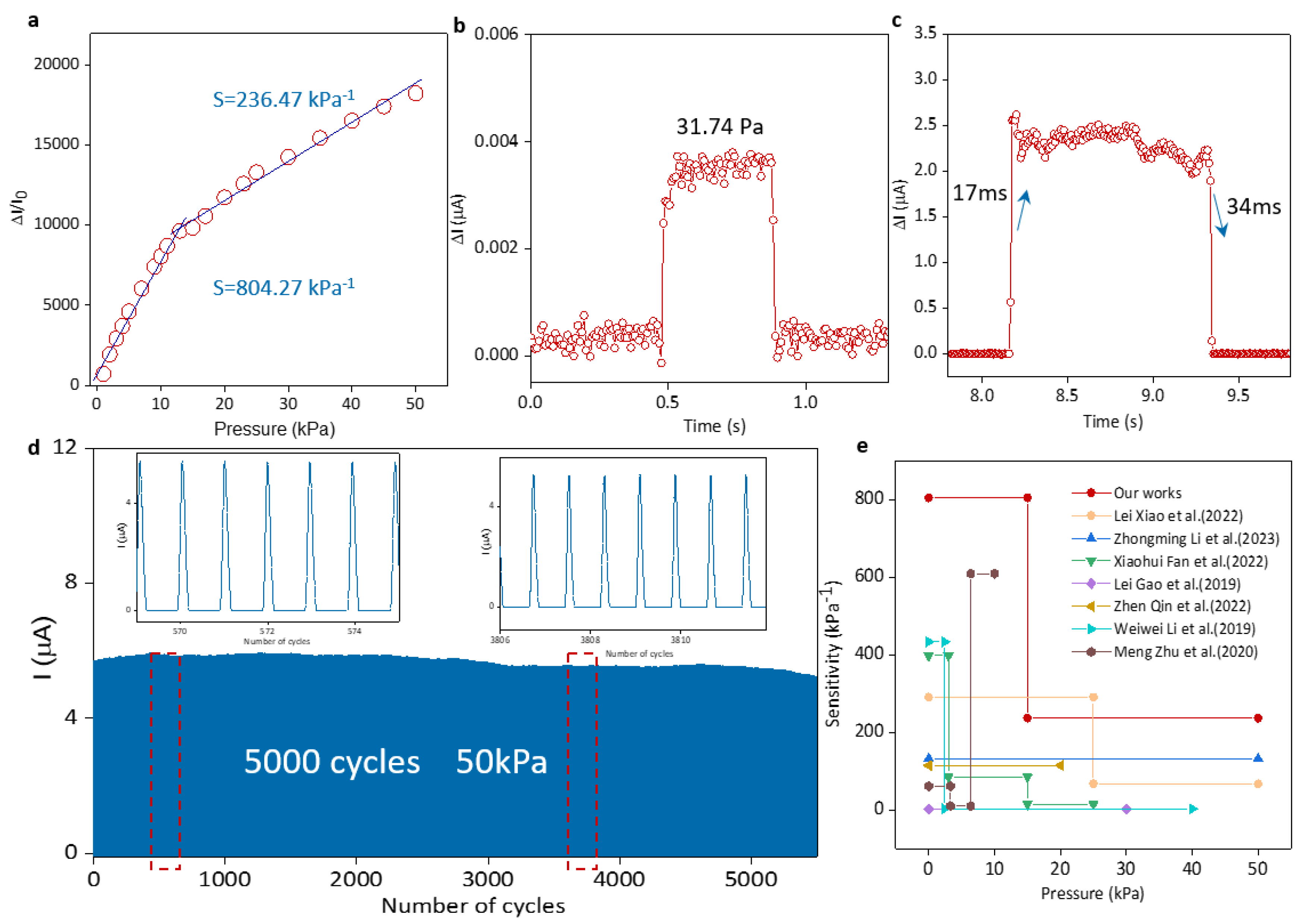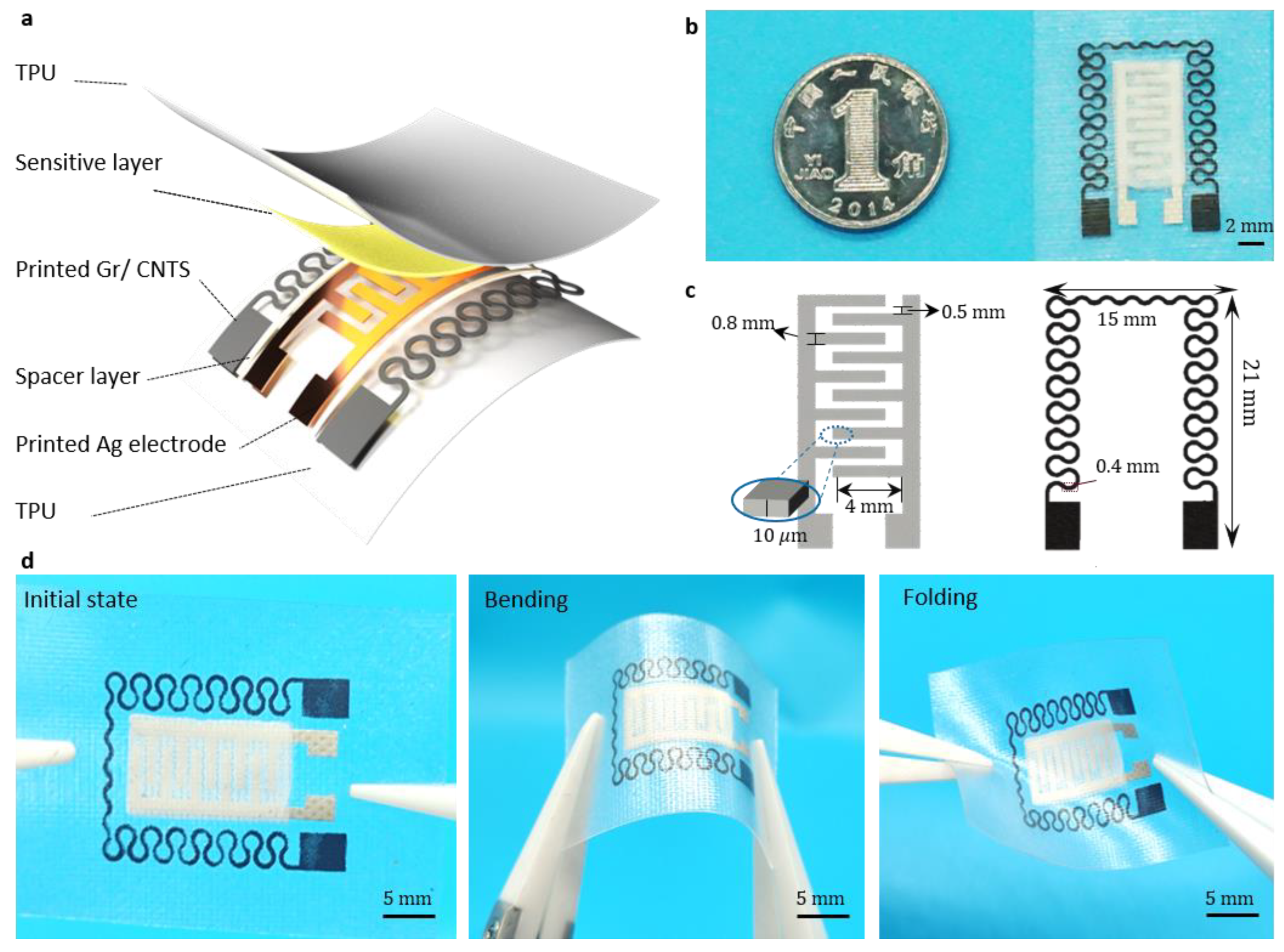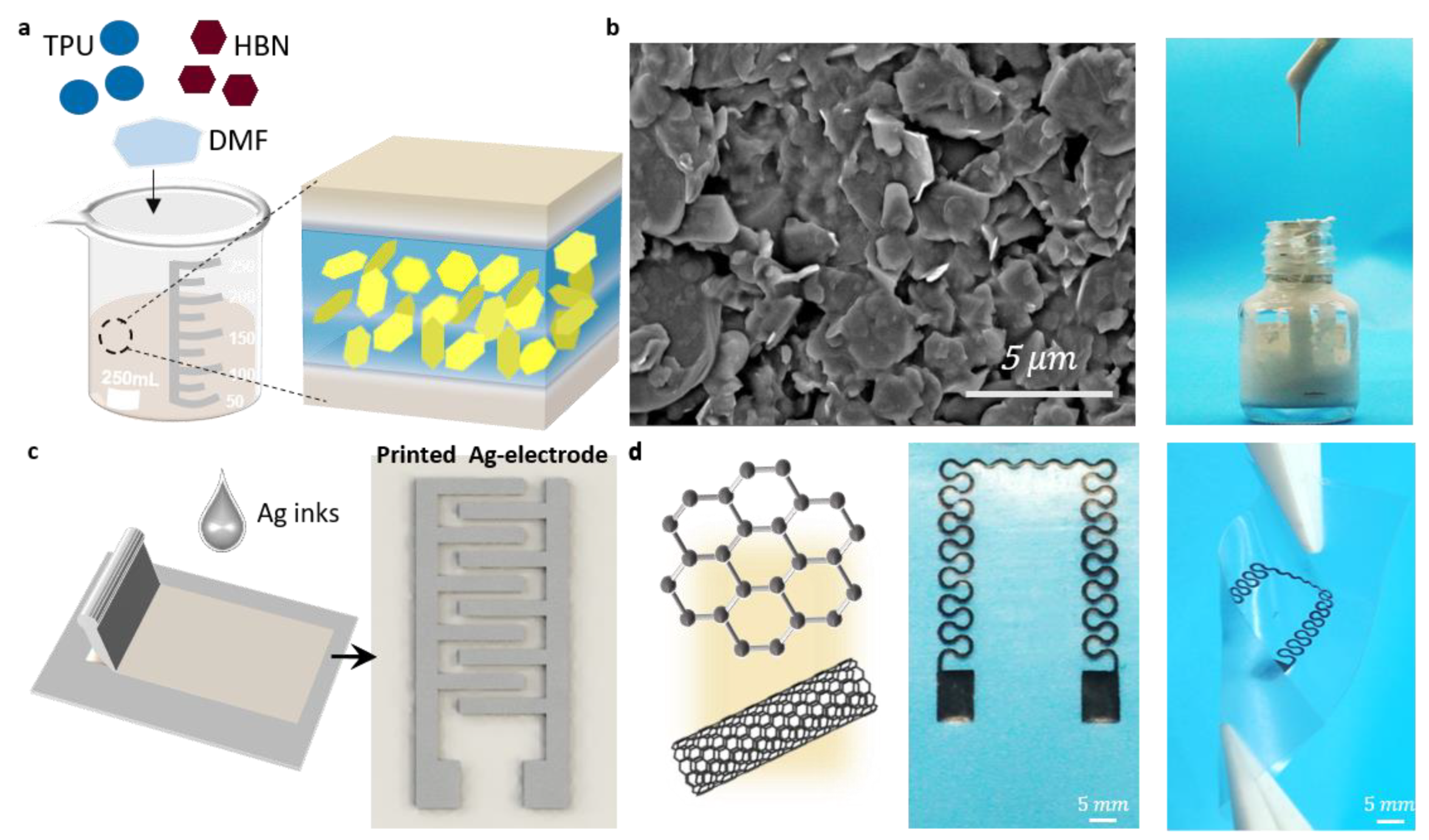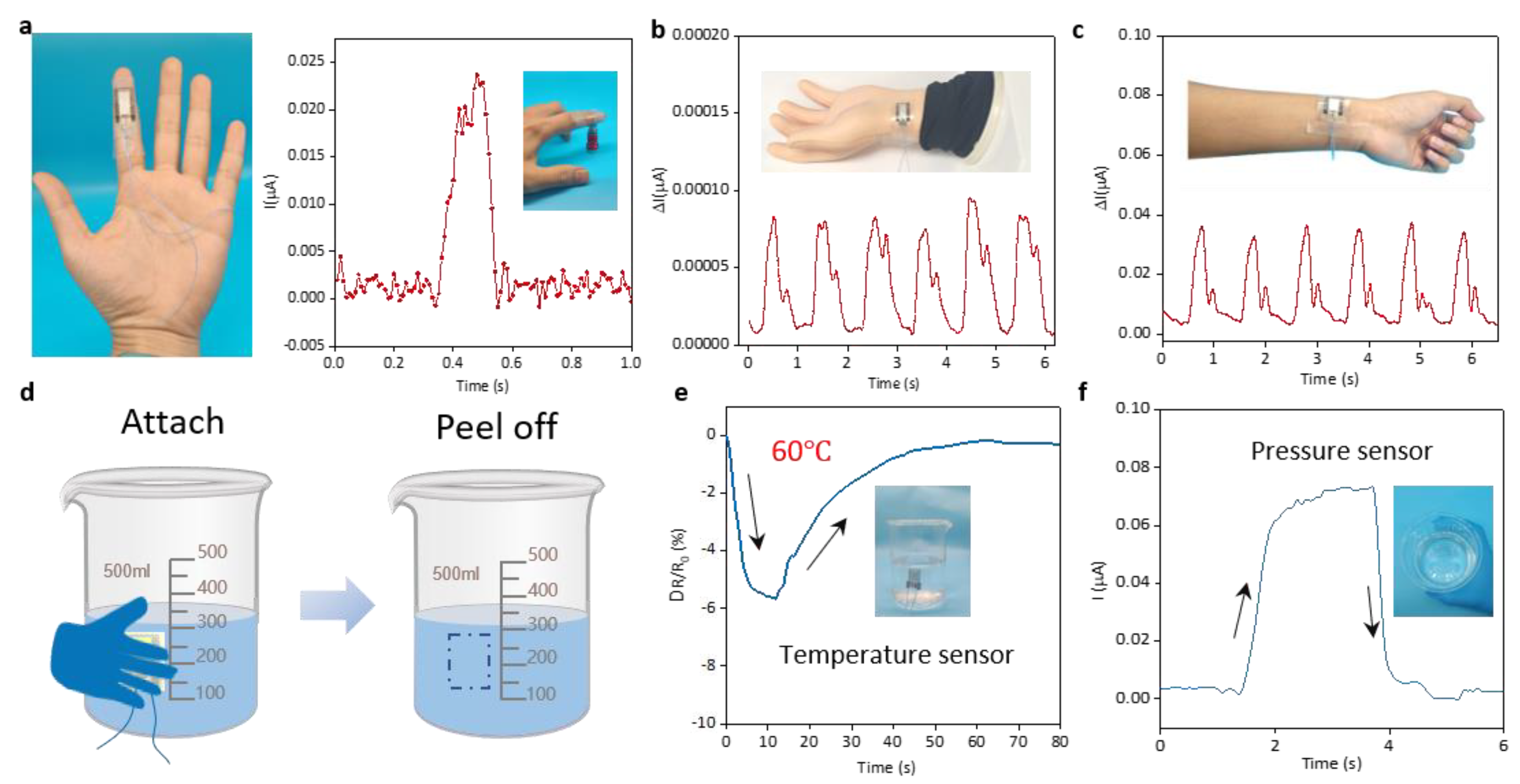A Dual-Mode Pressure and Temperature Sensor
Abstract
1. Introduction
2. Materials and Methods
2.1. Materials and Characterization
2.2. Structural Design
2.3. Preparation of Pressure Sensor
2.4. Preparation of Temperature Sensor
3. Results and Discussion
3.1. Performance of Pressure Sensor

3.2. Performance of Temperature Sensor
3.3. Application of Dual-Mode Sensors
4. Conclusions
Author Contributions
Funding
Data Availability Statement
Conflicts of Interest
References
- Gao, L.; Zhu, C.; Li, L.; Zhang, C.; Liu, J.; Yu, H.-D.; Huang, W. All Paper-Based Flexible and Wearable Piezoresistive Pressure Sensor. ACS Appl. Mater. Interfaces 2019, 11, 25034–25042. [Google Scholar] [CrossRef] [PubMed]
- Wang, Y.; Yue, Y.; Cheng, F.; Cheng, Y.; Ge, B.; Liu, N.; Gao, Y. Ti3C2Tx MXene-Based Flexible Piezoresistive Physical Sensors. ACS Nano 2022, 16, 1734–1758. [Google Scholar] [CrossRef] [PubMed]
- Wang, Z.; Guo, S.; Li, H.; Wang, B.; Sun, Y.; Xu, Z.; Chen, X.; Wu, K.; Zhang, X.; Xing, F.; et al. The Semiconductor/Conductor Interface Piezoresistive Effect in an Organic Transistor for Highly Sensitive Pressure Sensors. Adv. Mater. 2019, 31, 1805630. [Google Scholar] [CrossRef] [PubMed]
- Farman, M.; Surendra; Prajesh, R.; Upadhyay, A.K.; Kumar, P.; Thouti, E. All-Polydimethylsiloxane-Based Highly Flexible and Stable Capacitive Pressure Sensors with Engineered Interfaces for Conformable Electronic Skin. ACS Appl. Mater. Interfaces 2023, 15, 34195–34205. [Google Scholar] [CrossRef] [PubMed]
- Yang, X.; Chen, S.; Shi, Y.; Fu, Z.; Zhou, B. A flexible highly sensitive capacitive pressure sensor. Sens. Actuators A Phys. 2021, 324, 112629. [Google Scholar] [CrossRef]
- Gao, H.; Chen, T. A flexible ultra-highly sensitive capacitive pressure sensor for basketball motion monitoring. Discov. Nano 2023, 18, 17. [Google Scholar] [CrossRef]
- Liu, Y.; Yun, C.; Wang, Y.; Xu, L.; Wang, C.; Li, Z.; Meng, M.; Song, S.; Li, K.; Li, D.; et al. Radiation-Hardened and Flexible Pb(Zr0.53Ti0.47)O3 Piezoelectric Sensor for Structural Health Monitoring. ACS Appl. Mater. Interfaces 2023, 15, 49362–49369. [Google Scholar] [CrossRef]
- Shi, Y.; Tian, Y.; Guan, Y.; Kang, X.; Li, Y.; Ren, K.; Wen, C.; Ning, C.; Zhou, L.; Fu, R.; et al. All-Polymer Piezoelectric Elastomer with High Stretchability, Low Hysteresis, Self-Adhesion, and UV-Blocking as Flexible Sensor. ACS Appl. Mater. Interfaces 2023, 15, 43003–43015. [Google Scholar] [CrossRef]
- Cao, S.; Zou, H.; Jiang, B.; Li, M.; Yuan, Q. Incorporation of ZnO encapsulated MoS2 to fabricate flexible piezoelectric nanogenerator and sensor. Nano Energy 2022, 102, 107635. [Google Scholar] [CrossRef]
- Hayase, G. Optical tactile sensor using scattering inside sol-gel-derived flexible macroporous monoliths. Sens. Actuators A Phys. 2023, 354, 114253. [Google Scholar] [CrossRef]
- Kim, J.T.; Choi, H.; Shin, E.; Park, S.; Kim, I.G. Graphene-based optical waveguide tactile sensor for dynamic response. Sci. Rep. 2018, 8, 16118. [Google Scholar] [CrossRef]
- Peng, Y.; Li, D.; Yang, X.; Ma, Z.; Mao, Z. A Review on Electrohydrodynamic (EHD) Pump. Micromachines 2023, 14. [Google Scholar] [CrossRef] [PubMed]
- Dong, H.; Zhang, L.; Wu, T.; Song, H.; Luo, J.; Huang, F.; Zuo, C. Flexible pressure sensor with high sensitivity and fast response for electronic skin using near-field electrohydrodynamic direct writing. Org. Electron. 2021, 89, 106044. [Google Scholar] [CrossRef]
- Senthil Kumar, K.; Chen, P.-Y.; Ren, H. A Review of Printable Flexible and Stretchable Tactile Sensors. Research 2019, 2019, 3018568. [Google Scholar] [CrossRef] [PubMed]
- Wan, Y.; Wang, Y.; Guo, C.F. Recent progresses on flexible tactile sensors. Mater. Today Phys. 2017, 1, 61–73. [Google Scholar] [CrossRef]
- Lee, D.; Lee, H.; Jeong, Y.; Ahn, Y.; Nam, G.; Lee, Y. Highly Sensitive, Transparent, and Durable Pressure Sensors Based on Sea-Urchin Shaped Metal Nanoparticles. Adv. Mater. 2016, 28, 9364–9369. [Google Scholar] [CrossRef] [PubMed]
- Zheng, W.; Zhao, Y.; Xu, H.; Yuan, Y.; Wang, W.; Gao, L. Stretchable Iontronic Pressure Sensor Array With Low Crosstalk and High Sensitivity for Epidermal Monitoring. IEEE Electron Device Lett. 2023, 44, 516–519. [Google Scholar] [CrossRef]
- Cui, Z.; Poblete, F.R.; Zhu, Y. Tailoring the Temperature Coefficient of Resistance of Silver Nanowire Nanocomposites and their Application as Stretchable Temperature Sensors. ACS Appl. Mater. Interfaces 2019, 11, 17836–17842. [Google Scholar] [CrossRef] [PubMed]
- Wang, Y.; Sun, K.; Zhang, Q.; Yu, S.S.; Han, B.S.; Wang, J.; Zhao, M.; Meng, X.; Chen, S.; Zheng, Y. Flexible integrated sensor with asymmetric structure for simultaneously 3D tactile and thermal sensing. Biosens. Bioelectron. 2023, 224, 115054. [Google Scholar] [CrossRef]
- Zhou, Y.; Zhang, Y.; Zhou, Y.; Zhao, L.; Liu, F.; Yan, X.; Sun, P.; Lu, G. Waterproof breathable multifunctional flexible sensor for underwater tactile sensing and ammonia gas monitoring. Nano Energy 2023, 117, 108881. [Google Scholar] [CrossRef]
- Yang, Z.; Duan, Q.; Zang, J.; Zhao, Y.; Zheng, W.; Xiao, R.; Zhang, Z.; Hu, L.; Wu, G.; Nan, X.; et al. Boron nitride-enabled printing of a highly sensitive and flexible iontronic pressure sensing system for spatial mapping. Microsyst. Nanoeng. 2023, 9, 68. [Google Scholar] [CrossRef]
- Shi, H.; Al-Rubaiai, M.; Holbrook, C.M.; Miao, J.; Pinto, T.; Wang, C.; Tan, X. Screen-Printed Soft Capacitive Sensors for Spatial Mapping of Both Positive and Negative Pressures. Adv. Funct. Mater. 2019, 29, 1809116. [Google Scholar] [CrossRef]
- Li, R.; Zhou, Q.; Bi, Y.; Cao, S.; Xia, X.; Yang, A.; Li, S.; Xiao, X. Research progress of flexible capacitive pressure sensor for sensitivity enhancement approaches. Sens. Actuators A Phys. 2021, 321, 112425. [Google Scholar] [CrossRef]
- Xiao, Y.; Duan, Y.; Li, N.; Wu, L.; Meng, B.; Tan, F.; Lou, Y.; Wang, H.; Zhang, W.; Peng, Z. Multilayer Double-Sided Microstructured Flexible Iontronic Pressure Sensor with a Record-wide Linear Working Range. ACS Sens. 2021, 6, 1785–1795. [Google Scholar] [CrossRef] [PubMed]
- Li, Y.; Cui, Y.; Zhang, M.; Li, X.; Li, R.; Si, W.; Sun, Q.; Yu, L.; Huang, C. Ultrasensitive Pressure Sensor Sponge Using Liquid Metal Modulated Nitrogen-Doped Graphene Nanosheets. Nano Lett. 2022, 22, 2817–2825. [Google Scholar] [CrossRef]
- Chen, M.; Xu, L.; Liu, Y.; Yu, M.; Li, Y.; Ye, T.T. An All-Fabric Tactile-Sensing Keypad with Uni-Modal and Ultrafast Response/Recovery Time for Smart Clothing Applications. ACS Appl. Mater. Interfaces 2022, 14, 24946–24954. [Google Scholar] [CrossRef] [PubMed]
- Huang, J.; Zeng, J.; Liang, B.; Wu, J.; Li, T.; Li, Q.; Feng, F.; Feng, Q.; Rood, M.J.; Yan, Z. Multi-Arch-Structured All-Carbon Aerogels with Superelasticity and High Fatigue Resistance as Wearable Sensors. ACS Appl. Mater. Interfaces 2020, 12, 16822–16830. [Google Scholar] [CrossRef] [PubMed]
- Lee, Y.; Park, J.; Cho, S.; Shin, Y.-E.; Lee, H.; Kim, J.; Myoung, J.; Cho, S.; Kang, S.; Baig, C.; et al. Flexible Ferroelectric Sensors with Ultrahigh Pressure Sensitivity and Linear Response over Exceptionally Broad Pressure Range. ACS Nano 2018, 12, 4045–4054. [Google Scholar] [CrossRef]
- Zhu, J.; Xue, X.; Li, J.; Wang, J.; Wang, H.; Xing, Y.; Zhu, P. Flexible pressure sensor with a wide pressure measurement range and an agile response based on multiscale carbon fibers/carbon nanotubes composite. Microelectron. Eng. 2022, 257, 111750. [Google Scholar] [CrossRef]
- Lei, X.; Ma, L.; Li, Y.; Cheng, Y.; Cheng, G.J.; Liu, F. Highly sensitive and wide-range flexible pressure sensor based on carbon nanotubes-coated polydimethylsiloxane foam. Mater. Lett. 2022, 308, 131151. [Google Scholar] [CrossRef]
- Li, Z.; Feng, D.; Li, B.; Zhao, W.; Xie, D.; Mei, Y.; Liu, P. Ultra-Wide Range, High Sensitivity Piezoresistive Sensor Based on Triple Periodic Minimum Surface Construction. Small 2023, 19, 2301378. [Google Scholar] [CrossRef]
- Fang, X.; Zhao, S.; Qin, Z.; Lv, Y.; Pan, K. Fingerprint-Inspired High Conductive PEDOT-Coated Nanofiber Film for Ultra-Sensitive, Stretchable, and Flexible Piezoresistive Sensor. Adv. Mater. Technol. 2022, 7, 2100788. [Google Scholar] [CrossRef]
- Qin, Z.; Chen, X.; Lv, Y.; Zhao, B.; Fang, X.; Pan, K. Wearable and high-performance piezoresistive sensor based on nanofiber/sodium alginate synergistically enhanced MXene composite aerogel. Chem. Eng. J. 2023, 451, 138586. [Google Scholar] [CrossRef]
- Li, W.; He, K.; Zhang, D.; Li, N.; Hou, Y.; Cheng, G.; Li, W.; Sui, F.; Dai, Y.; Luo, H.; et al. Flexible and High Performance Piezoresistive Pressure Sensors Based on Hierarchical Flower-Shaped SnSe2 Nanoplates. ACS Appl. Energy Mater. 2019, 2, 2803–2809. [Google Scholar] [CrossRef]
- Zhu, M.; Yue, Y.; Cheng, Y.; Zhang, Y.; Su, J.; Long, F.; Jiang, X.; Ma, Y.; Gao, Y. Hollow MXene Sphere/Reduced Graphene Aerogel Composites for Piezoresistive Sensor with Ultra-High Sensitivity. Adv. Electron. Mater. 2020, 6, 1901064. [Google Scholar] [CrossRef]
- Cai, C.; Wen, C.; Zhao, W.; Tian, S.; Long, Y.; Zhang, X.; Sui, X.; Zhang, L.; Yang, J. Environment-Resistant Organohydrogel-Based Sensor Enables Highly Sensitive Strain, Temperature, and Humidity Responses. ACS Appl. Mater. Interfaces 2022, 14, 23692–23700. [Google Scholar] [CrossRef] [PubMed]
- Huang, J.; Yang, X.; Her, S.-C.; Liang, Y.-M. Carbon Nanotube/Graphene Nanoplatelet Hybrid Film as a Flexible Multifunctional Sensor. Sensors 2019, 19, 317. [Google Scholar] [CrossRef] [PubMed]
- Vuorinen, T.; Niittynen, J.; Kankkunen, T.; Kraft, T.M.; Mäntysalo, M. Inkjet-Printed Graphene/PEDOT:PSS Temperature Sensors on a Skin-Conformable Polyurethane Substrate. Sci. Rep. 2016, 6, 35289. [Google Scholar] [CrossRef] [PubMed]
- Sibinski, M.; Jakubowska, M.; Sloma, M. Flexible Temperature Sensors on Fibers. Sensors 2010, 10, 7934–7946. [Google Scholar] [CrossRef]
- Polanský, R.; Soukup, R.; Řeboun, J.; Kalčík, J.; Moravcová, D.; Kupka, L.; Švantner, M.; Honnerová, P.; Hamáček, A. A novel large-area embroidered temperature sensor based on an innovative hybrid resistive thread. Sens. Actuators A Phys. 2017, 265, 111–119. [Google Scholar] [CrossRef]
- Xiao, Y.; Jiang, S.; Li, Y.; Zhang, W. Screen-printed flexible negative temperature coefficient temperature sensor based on polyvinyl chloride/carbon black composites. Smart Mater. Struct. 2021, 30, 025035. [Google Scholar] [CrossRef]
- Courbat, J.; Kim, Y.B.; Briand, D.; Rooij, N.F.d. Inkjet printing on paper for the realization of humidity and temperature sensors. In Proceedings of the 2011 16th International Solid-State Sensors, Actuators and Microsystems Conference, Beijing, China, 5–9 June 2011; pp. 1356–1359. [Google Scholar] [CrossRef]
- Sappati, K.k.; Bhadra, S. Printed Polymer based Acoustic Sensor for Temperature Monitoring. In Proceedings of the 2020 IEEE International Conference on Flexible and Printable Sensors and Systems (FLEPS), Manchester, UK, 16–19 August 2020; pp. 1–4. [Google Scholar] [CrossRef]
- Liew, Q.J.; Abdul Rashid, N.; Lee, H.W.; Hawari, H.F.; Md Khir, M.H. Inkjet-Printed Flexible Temperature Sensor using Hybrid Reduced Graphene Oxide—Silver Nanoparticles(rGO/AgNPs) Conductive Ink and Silver Nanoparticles Ink. J. Phys. Conf. Ser. 2021, 1878, 012059. [Google Scholar] [CrossRef]
- Guo, Z.; Gu, Z.; Xue, J.; Gao, M.; Yu, Y.; Liu, H.; Lu, Y.; Xing, B.; Cao, Q.; Hu, C. Flexible germanium monotelluride phase change films with ultra-high bending stability for wearable piezoresistive sensors. J. Alloys Compd. 2023, 969, 172333. [Google Scholar] [CrossRef]
- Yang, N.; Yin, X.; Liu, H.; Yan, X.; Zhou, X.; Wang, F.; Zhang, X.; Zhao, Y.; Cheng, T. Dual-Layer All-Textile Flexible Pressure Sensor Coupled by Silver Nanowires with Ti3C2-Mxene for Monitoring Athletic Motion during Sports and Transmitting Information. ACS Appl. Mater. Interfaces 2023, 15, 42992–43002. [Google Scholar] [CrossRef]
- Xu, H.; Zheng, W.; Zhang, Y.; Zhao, D.; Wang, L.; Zhao, Y.; Wang, W.; Yuan, Y.; Zhang, J.; Huo, Z.; et al. A fully integrated, standalone stretchable device platform with in-sensor adaptive machine learning for rehabilitation. Nat. Commun. 2023, 14, 7769. [Google Scholar] [CrossRef]




| Material | Method | Measurement Range (°C) | RTC (%/°C) | Ref. |
|---|---|---|---|---|
| MWCNTs/GNP | Vacuum filtration | 30–100 | 0.138 | [37] |
| Graphene-PEDOT: PSS/PU | Inkjet printing | 35–45 | 0.06 | [38] |
| MWCNTs/PVDF | Printing/dip coating | 20–120 | 0.13 | [39] |
| Hybrid thread (PES-Steel microwire) | Embroidery | 40–120 | 0.1 | [40] |
| Polyvinyl chloride/carbon black (PVC/CB) | Screen printing | 18–44 | −0.148 | [41] |
| AgNPs | Inkjet printing | −20–60 | 0.11 | [42] |
| PZT/PDMS | Inkjet printing | 25–120 | 0.0875 | [43] |
| rGO/AgNPs | Inkjet printing | 30–100 | 0.1 | [44] |
| CNT/graphene | Screen printing | 12.5–93.7 | −0.17 | Our work |
Disclaimer/Publisher’s Note: The statements, opinions and data contained in all publications are solely those of the individual author(s) and contributor(s) and not of MDPI and/or the editor(s). MDPI and/or the editor(s) disclaim responsibility for any injury to people or property resulting from any ideas, methods, instructions or products referred to in the content. |
© 2024 by the authors. Licensee MDPI, Basel, Switzerland. This article is an open access article distributed under the terms and conditions of the Creative Commons Attribution (CC BY) license (https://creativecommons.org/licenses/by/4.0/).
Share and Cite
Chai, J.; Wang, X.; Li, X.; Wu, G.; Zhao, Y.; Nan, X.; Xue, C.; Gao, L.; Zheng, G. A Dual-Mode Pressure and Temperature Sensor. Micromachines 2024, 15, 179. https://doi.org/10.3390/mi15020179
Chai J, Wang X, Li X, Wu G, Zhao Y, Nan X, Xue C, Gao L, Zheng G. A Dual-Mode Pressure and Temperature Sensor. Micromachines. 2024; 15(2):179. https://doi.org/10.3390/mi15020179
Chicago/Turabian StyleChai, Jin, Xin Wang, Xuan Li, Guirong Wu, Yunlong Zhao, Xueli Nan, Chenyang Xue, Libo Gao, and Gaofeng Zheng. 2024. "A Dual-Mode Pressure and Temperature Sensor" Micromachines 15, no. 2: 179. https://doi.org/10.3390/mi15020179
APA StyleChai, J., Wang, X., Li, X., Wu, G., Zhao, Y., Nan, X., Xue, C., Gao, L., & Zheng, G. (2024). A Dual-Mode Pressure and Temperature Sensor. Micromachines, 15(2), 179. https://doi.org/10.3390/mi15020179








